Structure of Cell
Structure of Cell of Class 11
CELL WALL
Characteristic feature of plant cells not found in animal cells. However, it is absent from mycoplasma and gametes of plant cell.
It constitutes a kind of exoskeleton that provides protection and mechanical support for the plant cell which helps to maintain a balance between the osmotic pressure of the intracellular fluid and the tendency of
water to penetrate cell.
Composition
Consist of a microfibrillar network lying in a gel-like matrix of interlinked molecules.
The microfibrils are mostly cellulose chains which by intra and intermolecular hydrogen bonding produce the structural unit known as microfibril.
Each microfibril is 25 nm in diameter and is composed of about 2000 glucan chains. Microfibrils in turn associate among themselves and with non-cellulosic polysaccharides and proteins to form the cell wall.
Gel matrix, in addition to protein, contains some polysaccharides (Pectin substances and hemicelluloses) and lignin (found only in mature cell walls).
Certain cell walls may have cuticular substance (cutin wax) and mineral deposits in the form of calcium and magnesium carbonates and silicates.
In fungi and yeasts the cell wall is composed of chitin, a polymer of N-acetyl glucosamine.
Formation
Begins at late anaphase and continues through the telophase.
The cell plate which is formed from vesicles of the Golgi complex becomes aligned at the equatorial plane and forms the intercellular layer or middle lamella.
After cell division, each daughter cell deposits other layer that constitutes the primary cell wall, when the cell has enlarged to its mature size usually with the development of large vacuoles, the secondary wall
appears by apposition of new materials on the primary cell wall.
Structure
The cell wall is differentiated into three layers :
(a) Middle lamella : Binds the two adjacent cells firmly. It is an amorphous layer composed of calcium and magnesium pectate. In the softer tissues of the plant e.g.
pith, cambium, etc., it remains unlignified while in woody tissues it is highly lignified. In fleshy fruits during ripening the pectin of the middle lamella is dissolved by the proteolytic enzymes, the cells are, therefore, loosened and the fruit becomes soft. 
Fig. A cell in T.S. showing parts of cell wall
(b) Primary wall : Primary wall is thin and elastic capable of growth and extension, composed largely of cellulose with some pectic substances. Becomes lignified and thick after growth stops.

Fig. Ultrastructure of a generalised plant cell
(c) Secondary wall : Secondary wall particularly of sclerenchyma is very thick and rigid and consists of three layers — outer (S1), middle (S2) and inner (S3) layers. The cellulose microfibrils of these layers are embedded in a matrix composed of hemicellulose, lignin, pectin etc.
Sometimes secondary wall layers are not deposited in the adjacent cells and such thin spots are called simple pits. The middle lamella and the two primary walls in the pit region together constitute the pit membrane, which has a thickening called torus.
Functions
Provides mechanical support and protection.
Allows a pressure potential to be developed which aids in support.
Prevents osmotic bursting of the cell. It is a pathway for movement of water and mineral salt.
Various modifications, such as lignification, provide for specialised functions.
Cell Coat
A distinct layer of glycocalyx is observed in the outer surface of cells in many animals and protistans.
Fibrous and made up of oligosaccharides-which are actually part of plasma membrane.
In some cases cell coat is thickened by deposition of calcium, silicon and other salts.
Protective and provides shape to the cells.
Useful in recognition between microbe and body cell by WBCs and involved in histocompatibility.
Helps in cell aggregation and tissue formation.
Blood grouping is based on specific antigens present in the cell coat of erythrocytes.
- Introduction of Cell
- Concept of Protoplasm
- Theory of Cell
- Cell organization
- Cell Size
- Cellular Totipotency
- Types of Cell
- Flow of Information
- Structure of Cell
- Cell Membrane
- Endoplasmic Reticulam
- Golgi Appratus
- Lysosomes
- Mitochondria
- Plastids
- Nucleus
- Chromosomes
- Ribosomes/Palade Particles/Protein Factories
- Microbodies
- Centrioles
- CILIA AND FLAGELLA
- Cytoskeletal Structures
- Cytoskeletal Structures
- Exercise 1
- Exercise 2
- Exercise 3
- Exercise 4
- Exercise 5
- Exercise 6









